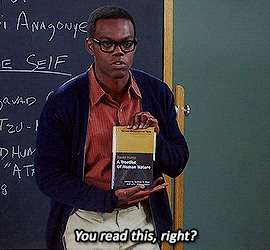Read time: 7 minutes
In a perfect world, we would’ve had our persuasion and GOTV scripts written and vetted weeks ago. But we don’t live in a perfect world. The news cycle’s been bananas, you’ve been hard at work fundraising and preparing your mailers and recruiting an army of volunteers, plus the third season of The Good Place just started, so things have been a little bit busy.

So, before you sit down to bang out those scripts, here’s our no-bullshirt guide to writing a canvassing, phonebanking, or SMS script that will compel voters to support your issue or candidate…and turn out and vote the right way come November 6.
Here’s the skinny:
Persuasion Scripts
You’ve still got a couple weeks to persuade voters to come to your side. And whether it’s at the door, on the phone, or via text, persuasion is about making a connection. Persuasion scripts are usually a lot longer and more conversational than an initial ID or GOTV script because you’re trying to get at the heart of why an undecided voter is still on the fence.
Ask the voter what matters most to them, and define what’s at stake on that issue. If they care about health care, talk about how you can expand access to affordable health care if you flip the House. If it’s increased cost of living and the challenges of making ends meet, talk about your candidate’s plan to raise the minimum wage.
Be specific here. The more you can connect their concerns to your candidate’s positions, the more likely you are to win over the skeptics.
Aim to understand how that voter is feeling right now, and use that feeling as a motivation to act. For all the talking points and data you’ve got, the most effective tool you have this election cycle might be the ability to listen to a voter, understand where they’re at, and draw a connection between how they’re feeling and your candidate/cause.
Scores of studies show people feel first and then look up facts to back up that feeling. Whether the voter is hopeful, frustrated, or angry, put space in your script to connect (“I know what you mean, I’m so disgusted by the political process nowadays too!”) then pivot to how your candidate or cause can change things.
Don’t be afraid to tap into your inner Janet: In a loud race where lots of negativity is flying, research shows positive messaging can have an impact.

Share information – such as endorsements or facts about the race. If your candidate is running for district attorney, talk about what the DA does and why it’s so important. Mention the organizations or people who have endorsed your candidate to add some third-party validators to the mix. These tactics can be especially convincing for low-information voters (people who vote but may not spend all day and night thinking about and worrying about and tweeting about politics the way that you do).

Emphasize the importance of their vote. After you’ve done the above, you’ll want to ask if you can count on the voter to vote for your cause or candidate. And if they will, now’s the time to speak to their identity. Don’t just rely on trite statements like “Every vote counts!” Show them every vote counts by reminding them of all the recent races that have come down to just a few votes, or, if you have it, information on how close this race will be.
Have a clear call to action. After having a meaningful conversation with a voter, you don’t just say, “Well, nice talking to you. Bye!!” You close with an ask, because you’re an organizer and that’s what we do. We have found that for your ask to be persuasive, it should be two things: singular and specific.
Think about it: if you end your conversation saying, “I’m so glad we talked. Can I count on you to support Jason Mendoza for District Attorney by volunteering with him, coming to his fundraiser next Saturday, and voting for him in November?” it’s not going to go well. Stick to one ask, and save your additional asks for follow up questions.
And, if your ask is, “Any final questions I can answer about Jason Mendoza?” you’re not really getting the data you want. Be direct and clear: “Can I count on you to support Jason on November 6?”
Now that you’ve got your persuasion text locked in, I’m sure you’re eager for the next step.

G-O-T-Motherforking-V
Once you’ve done your persuasion and ID’ed your people, it’s time to get them to vote. GOTV conversations are short, so you have to get it right, right away. You probably know a good GOTV script asks voters to make a plan to vote (and how to vote by mail or vote early if it applies to your state), but what else should you say?

We’ve found that effective GOTV scripts invariably include:
A fair bit of social pressure. Tap into voters’ innate desire to follow social norms and do good deeds. Recapping a voter’s voting history or that of their neighbors can also remind the skeptics out there that people do care whether or not they vote.
How much pressure you want to exert is up to you and your organization’s comfort level. We’ve written scripts that range from the very softest of taps (“While who you vote for is private, whether you vote is public record. Can I count on you to vote this year?”) to a full on push (“Official records show you voted in 2012 and 2016, but you skipped voting in the 2014 election.”).
Reminding voters of why voting is important to them by asking why they’re voting. At this point in the election cycle, there’s no time to waste in laying out the many reasons why voting is important or their personal feelings on every issue in the race. But you can still tap into those all-important emotions while GOTVing by asking, “Why is voting this year so important to you?” Having people verbalize their motivation (or type it, if you’re texting them) while making a plan increases the likelihood they’ll actually follow through.
A compliment or two for good measure. I like to close every GOTV script I write with something like, “This race is going to come down to a handful of votes. Thanks for being the kind of person who votes and making your voice heard.”
It’s not (only) a nice compliment. It’s convincing the skeptics by again reminding them that one vote will make a difference in this race. It’s speaking to identity—who wouldn’t want to be the kind of virtuous person who votes? And it defines the moment: this race will be close, and we need them to take action.
End with a clear call to action. Remember what I said above? That applies here too. But because we know the more a voter visualizes their plan to vote, the more likely they will be to act on that plan, we want to take it a step further.
When GOTV rolls around, don’t say, “Can I count on you to vote for Jason Mendoza?” and call it a day. Follow up by asking what time of day they’ll vote, how they’ll get to their polling place (and if they know where it is!), and whether they’ll bring a friend to the polls. Repeat their plan back to them for extra stickiness.
Now…go forth! Whether you’re texting, knocking, or dialing, I hope you persuade and turn out every last person in your universe with your effective, powerful writing. Happy campaigning!

P.S. If you’d like more details on crafting your script, along with some lovely sample scripts, this guide from Wellstone is 😍. You can also follow our own four-step approach to writing effective direct response copy.
Okay, that’s all you need!

